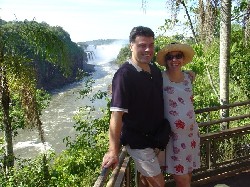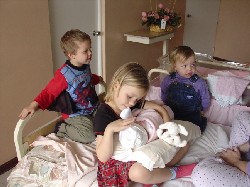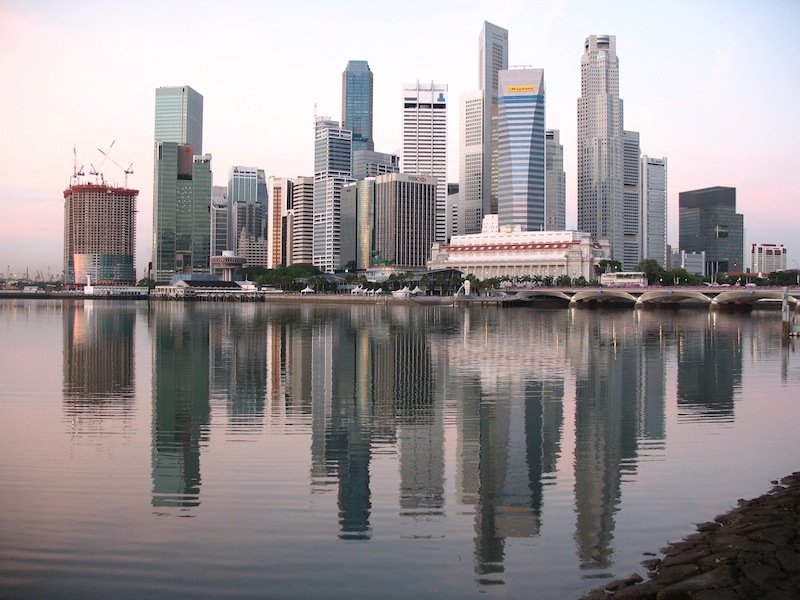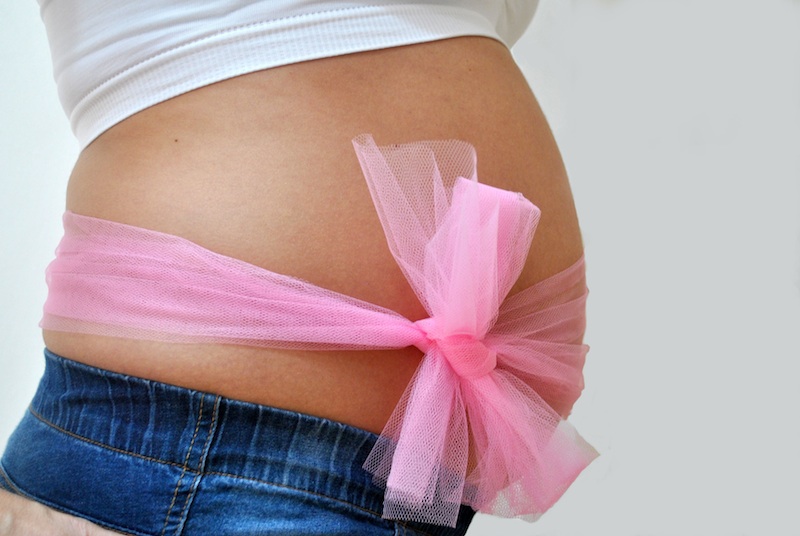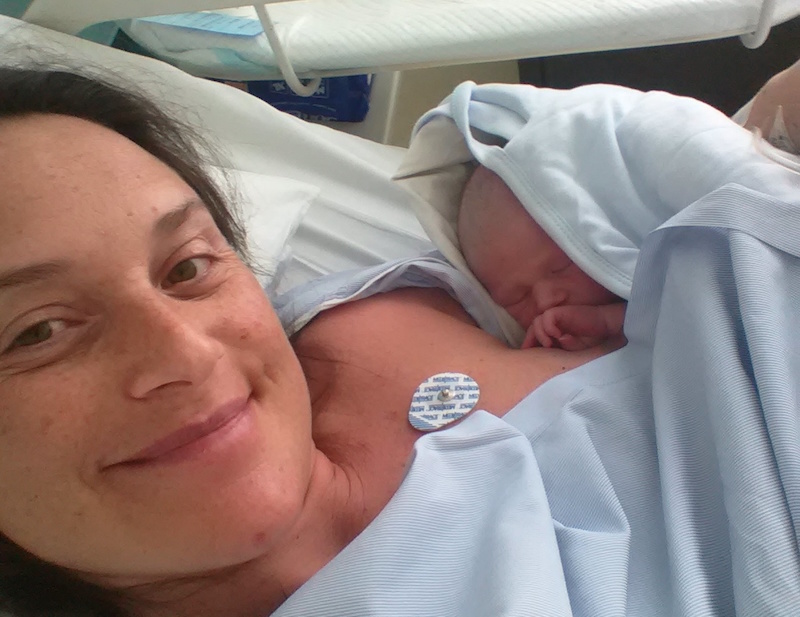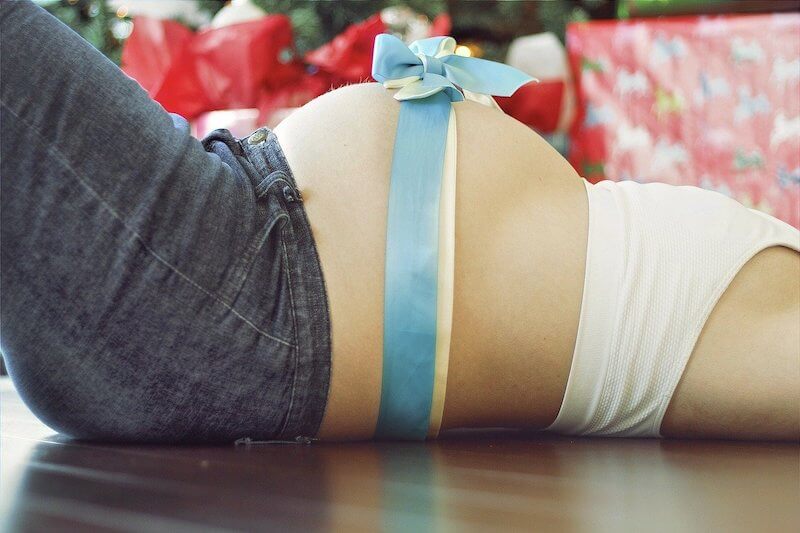
This is the account of our Kirstenexpat about her birth in Peru.
My name is Kirsten, and this is the story of my birth in Peru.
I am American and my husband Holger is German. I gave birth in Belgium to Rebecca in April 1999, Henry in August 2000 and Isabel in August 2002. When I found out in November 2003 that I was pregnant again, it was quite frankly neither a shock nor a surprise.
The fact that we had moved from Brussels to Lima didn’t make the situation any more complicated. After a year of living in the capital of Peru I was sure that the local medical care/facilities would be more than adequate. Also I would not be facing a move halfway around the world right after giving birth as I had after my third baby. And the fact that I had so recently had three uncomplicated pregnancies followed by three relatively easy deliveries made me very confident of my birthing abilities!
My pregnancy
A blood test with my gynecologist confirmed the results of peeing on the little white stick: we were going to be VERY busy in the coming years. For the next 9 months, I saw my doctor every 4 weeks in a private clinic with excellent facilities.

June 2004 and we’re all waiting for baby number 4
He did an ultrasound every visit, and we had a 4-D ultrasound at 36 weeks. In case of developmental problems with the baby, it would still have been possible for me at this point to fly to Europe or the US for specialised treatment.
Regular blood and urine tests showed everything fine, as did the glucose test. I only had to take a pregnancy vitamin and continue with the folic acid.
I did develop some varicose veins but the specialist who checked these had his office right next to my doctor, so it was easy to make sure nothing was really wrong (and three months after the birth of the baby the veins had gone back to normal, hurrah).
Preparation for the birth
It is sad to say that almost 80% of all hospital births in Lima are caesarians, so most of the birth preparation consists of picking a date and time for the operation! Of course, the many women who give birth in the slums of Peru are not included in this statistic. The high rate is due to two major factors: poor women are not given a choice as the doctors/hospitals prefer the certainty and higher billing options of a caesarian. And for many rich women, a natural childbirth is seen as simply too primitive. The notion of ‘too posh to push’ certainly applies in Lima. In fact, in the exclusive private clinic where I had my baby, only 1 in 20 births is a natural one. And I’m convinced most of those are by foreign women!
Luckily, I had a wonderful doctor who didn’t even mention the c-word to me. He did give me the name of a physiotherapist with whom I had some deep relaxation sessions, but I must admit that I felt I knew more about giving birth than she did. Apart from that, there was absolutely no ‘physical’ preparation.
Some Peruvian friends and some American friends had baby showers for me. This is a North American custom which has also become popular in South America. Women gather before the birth to give baby presents to the mother-to-be. Many parents here actually set up a registry at local department stores so that they receive the gifts for the infant they have chosen, very much like a bridal registry. While I enjoyed the baby showers, I can imagine it would be difficult for many Europeans and women from other cultures to have such a party BEFORE the safe arrival of the infant.
I would say another important aspect of preparing for the arrival of our fourth baby was getting away for a few days. My husband and I flew to Argentina and Brazil when I was 5 months pregnant and spent a week on our own, sightseeing and relaxing. I would never have done that with the first baby, but by number 4 things look very different.
I did register with the Clinic to let them know I was planning on giving birth there and requested a private room. I was informed that the hospital only had private rooms, and that my options were limited to the SIZE of the room. I chose the smallest available unit, which was perfectly adequate, and passed up on the chance to get the large suite which had an extra bed for the nanny and a reception room (complete with bar and catering service) for the many guests expected to visit the newborn and its exhausted mother.
Peruvians are very image conscious and lay great stock on external appearances. For that reason, I was also told that the hospital had hairdressers and a manicurist on call. I later spoke to another woman who had given birth at the same hospital who said her nurse was shocked that the mother-to-be had come to the hospital without a full make-up bag!
D-Day
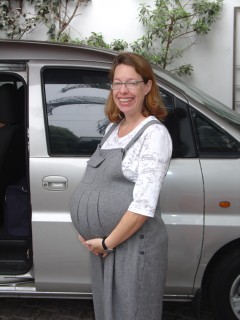 Nathalie’s due date was the 25th July and since the exam on that day showed that the amniotic sac was losing fluid, it was decided to schedule an induction for Friday, 30th July. Since my other children had all been induced as well, I wasn’t concerned. The 28th and 29th July are national holidays in Peru, so when I went in on the Friday, it turned out I was the only woman to give birth that day. This was because all the other doctors had scheduled the c-sections for their patients before the holidays.
Nathalie’s due date was the 25th July and since the exam on that day showed that the amniotic sac was losing fluid, it was decided to schedule an induction for Friday, 30th July. Since my other children had all been induced as well, I wasn’t concerned. The 28th and 29th July are national holidays in Peru, so when I went in on the Friday, it turned out I was the only woman to give birth that day. This was because all the other doctors had scheduled the c-sections for their patients before the holidays.
This time my labor progressed exactly as all the others had: induced at 9 am, strong contractions every minute until about 2 pm, then the relief of an epidural, followed by more intense contractions (luckily now without pain) until slowly, slowly, after 12 hours of labor, I was 10 cm dilated. At that point I really just needed to push one time and the baby was there. Honestly, all four of my babies have come out in EXACTLY the same way. Maybe that’s another reason they all look so much alike (see photo).
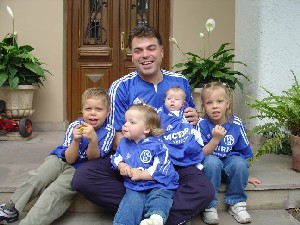
Holger and four little look-alikes.
The special thing about Nathalie’s birth was that not only my husband but also my mother were present. Since I was the only woman giving birth at the maternity clinic that day, the doctor allowed me an extra visitor. We called my mother after I had had the epidural, and she stayed right through the long afternoon with me. We drank anise tee and chatted about how different this experience was from her own deliveries. In the 1960’s in California, she had been knocked out cold and just handed her baby hours after it was dragged from her body.
Giving birth to my brother in Libya in 1970 must have been quite terrible, with primitive and uncaring medical care and a civil war going on. My mother was so very emotional when my baby arrived. It was a wonderful experience for all of us.
And so our three little Brussels Sprouts were joined by a Lima Bean…
Staying in hospital
A month or two before my due date, I had written a letter to the clinic, also signed by my doctor, stating that I wanted some changes to their normal hospital procedures. I was expecting to exclusively breastfeed my baby (which is very unusual with the wealthier segments of Peruvian society) and that my baby would room-in with me and not go to the ‘Sala de Bebes’. The hospital agreed to my requests.
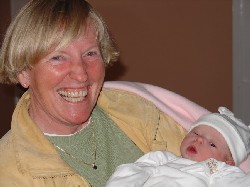
A happy Grandmother
Immediately after Nathalie’s arrival, I got to hold her for a few minutes. I was then told she would be taken away for 20 minutes to be cleaned (not bathed), weighed, measured and dressed. I asked the nurses to make sure that I was given my baby back as soon as possible. While I was quickly and efficiently taken care of, Nathalie was nowhere to be seen. I had to personally call the ‘Sala de Bebes’ several times and talk very forcefully to the people in charge. After more than two hours of waiting, I was informed that, ‘Senora, we are right now combing her hair so she will look pretty for her first photos‘.
I got quite nasty (those hormones, you know) and informed the nurse that my baby was much more interested in being put on the breast than having a little pink ribbon glued on her bald pate. Three minutes later, Nathalie arrived all washed and combed. She latched on immediately and I’m still almost exclusively breastfeeding her at 7 months (she doesn’t like her baby food as she wants to eat steak and fries like her older siblings).
Most newborns in the clinics are kept in a separate Baby Room and only brought to the mother when there are visitors. They are put on formula and a rigid feeding schedule immediately and there is almost no help in getting breastfeeding established. The mothers cannot bathe the babies themselves or put their own clothes on (the hospital provides little tops and wrap-arounds).
So my insistence on keeping Nathalie with me 24 hours a day and letting her latch on whenever she wanted was met by total disbelief by the nursing staff. I complained one evening that my room was too cold for the baby and the nurse’s solution was to scoop Nathalie up and say ‘I’ll just take her to the Baby Room then’. I told her to put my baby down immediately and go get me a space heater. This she rather reluctantly did.
But on the whole the nurses were friendly enough and listened when I asked for something. My doctor came by for a chat and check-up every day and a pediatrician thoroughly examined the baby. There really was no faulting the room, the food, or the medical care. I’m sure if I had taken advantage of the in-house hairdresser I would have been satisfied with her work too!
Because all the rooms are private, the number and hours of visiting are quite liberal. I was very careful that my personal visitors (husband, 3 kids, parents) didn’t come too often, stay too long, or make too much noise. We had also made the decision not to tell most people about the arrival of Nathalie until after I was safely back home again. But I was definitely the only mother in that hospital who was so considerate. The other visitors had regular fiestas until very, very late at night with champagne corks popping, food being served, kids running screaming up and down the halls, loud music, etc. After 2 days, all I wanted to do was go home, a place that suddenly seemed calm and restful in comparison to the clinic.
Checking out
We had to fill in a few papers, pay our bills, and have a doctor sign Nathalie out as a healthy baby. Then it was just a matter of trying to get all the beautiful flower bouquets that had arrived at the hospital in the car, together with our little bundle, and head home to the joyful greetings of Nathalie’s siblings.
Costs
The health insurance from my husband’s job is very generous, so we paid everything upfront and were later reimbursed 100%. The hospital fees were USD 800 for room, board and care. My doctor charged USD 1200 for the delivery. Interestingly, he charges the same for a caesarian as for a natural birth. Since Nathalie took 12 hours to arrive, he certainly earned his money that day!
Paperwork
All children born in Peru are automatically Peruvian citizens. My husband filled out the extensive and complicated paperwork and spent two half-days at the local municipality trying to get our baby registered. That is quite typical here. We also needed special papers and seals/stamps so that we could declare her births at the foreign embassies here.
My husband and I spent a few hours at the US Embassy getting her US ‘Registration of a Birth Abroad’ document and US passport, and then another eternity at the German Embassy getting her papers there in order. I later took her downtown to get her Peruvian passport. And just to complicate matters, I became a dual Belgian citizen a few months after the birth of Nathalie so she automatically became Belgian too.
Four months old and the proud bearer of four nationalities!
To sum up my birth in Peru
Giving birth in Peru was a pleasantly low-key and satisfying experience. Apart from some minor details, the pregnancy and birth experience were very similar to my other ones in Belgium. All mothers need to be prepared so they know what they want, and then insist on getting it.
It was wonderful that my parents were here for the birth. They helped keep the other kids entertained and also got to experience first-hand the joy and excitement of a new baby in the house. I am so grateful they made the effort to travel all the way from Australia to South America to be with us.
On the negative side was the thing that all expats dread: the loss of good friends due to re-location. My two best friends here in Lima, Brook and Patty, both moved back to the US only days before Nathalie was born. After keeping me and my growing belly company for 9 months, they never got to see my baby. It is a situation that comes up over and over again for people like us who are always ‘on the move’, but it doesn’t make it any easier. Luckily we have the internet and I regularly send them photos of the baby.
Many expat women are advised by their husband’s employer to return to the US or to Europe to have their babies. From personal experience, I would say this is only necessary if either the mother or the baby need some kind of special medical attention. For a normal pregnancy with a healthy baby expected, there is absolutely no reason not to have a happy birth experience here and take home your very own little Peruvian .
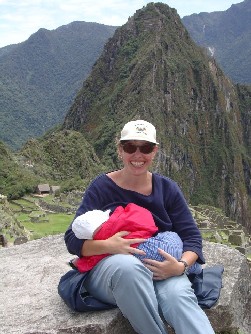
Breastfeeding Nathalie at Machu Picchu, Feb 05

